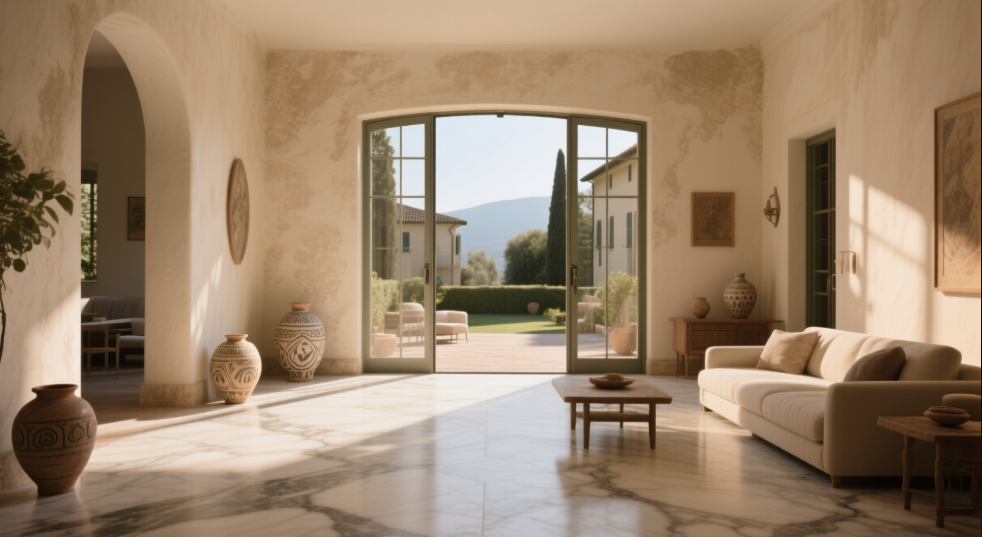
Italian tiles have long been a beacon of craftsmanship and style, shaping the world of interior design. Renowned for their durability and aesthetic innovation, Italian ceramic tiles continue to set global trends. In 2025, the focus is on natural textures, sustainable practices, and bold creative expressions. Here’s what’s driving the future of Italian tiles this year.
Nature-Inspired Designs
In 2025, Italian ceramic tiles are drawing heavily from the natural world. Designs mimic the organic textures of stone, clay, and timber, moving away from highly polished surfaces. These tiles embrace subtle imperfections, such as uneven edges or soft color gradients, to create an authentic, earthy feel.
Travertine-inspired Italian tiles, with their creamy tones and porous textures, are a standout choice. Slate-like designs, featuring rugged, matte finishes, also bring a sense of calm to interiors. These tiles allow homeowners to craft spaces that feel grounded in nature while retaining the practicality of ceramic.
Warm and Welcoming Colors
The dominance of cool greys is fading, replaced by warm, inviting hues. Italian tiles in 2025 feature shades like sand, caramel, and soft terracotta, creating cozy yet sophisticated spaces. These modern terracotta tones are lighter than their rustic predecessors, often infused with hints of blush or ivory.
Italian ceramic tiles in these palettes are incredibly versatile, pairing seamlessly with materials like wood, brass, or linen. They suit a range of aesthetics, from sleek modern lofts to charming traditional homes, offering a timeless foundation for design.
Bold Marble Effects
Marble-inspired Italian tiles are taking a dramatic leap in 2025. Designers are embracing tiles with striking veining and vibrant color contrasts—think creamy slabs with deep navy veins or charcoal tiles with golden streaks. These bold patterns turn surfaces into statement pieces.
Large-format Italian ceramic tiles enhance this trend, creating seamless, expansive surfaces that mimic the grandeur of natural marble. Their durability and low maintenance make them ideal for luxurious spaces like grand entryways or modern bathrooms.
Bridging Indoor and Outdoor Spaces
As homes increasingly integrate indoor and outdoor areas, Italian tiles are rising to the challenge. In 2025, manufacturers offer collections with weather-resistant, slip-proof properties, perfect for patios, terraces, or interior floors. The key trend is continuity—tiles that maintain a consistent aesthetic from a kitchen to a garden.
This seamless flow creates cohesive, open spaces that feel connected to their surroundings. Italian ceramic tiles make it possible to design environments that are both functional and visually harmonious, enhancing the modern home.
The Artisanal Charm
The handmade aesthetic is a defining trend in 2025. Italian tiles feature irregular shapes, hand-painted patterns, and uneven glazes that evoke the charm of small-scale craftsmanship. Some designs mimic the texture of hand-molded clay, while others resemble delicate, watercolor-like motifs.
This trend reflects a cultural shift toward authenticity. Italian ceramic tiles, rooted in Italy’s tradition of regional workshops, deliver surfaces that feel personal and unique, adding character to both modern and traditional spaces.
Sustainability as a Core Value
Sustainability is a priority in 2025. Italian tile manufacturers are adopting eco-friendly practices, incorporating recycled materials and optimizing production to reduce energy and water use. Italian ceramic tiles are also designed for longevity, minimizing the need for frequent replacements.
For environmentally conscious consumers, Italian tiles offer a balance of style and responsibility. Their durability and sustainable production methods make them a smart choice for eco-friendly design.
Tiles in Creative Applications
Italian tiles are breaking free from their traditional roles in 2025. Designers are using them for kitchen countertops, fireplaces, and even furniture. Thin, lightweight Italian ceramic tiles make these applications possible, combining the strength of ceramic with the flexibility to clad unique surfaces.
Imagine a dining table wrapped in stone-effect tiles or a staircase clad in marble-look ceramic. These uses blend aesthetics with practicality, as ceramic resists stains and wear better than many natural materials.
Texture as a Design Statement
Texture is redefining luxury in 2025. Italian tiles are embracing matte finishes, embossed patterns, and three-dimensional designs that add depth to surfaces. Tiles with subtle ridges or woven textures create dynamic visuals that shift with the light, bringing spaces to life.
These tactile surfaces elevate Italian ceramic tiles beyond mere decoration, making them a sensory experience. They redefine how we interact with surfaces, prioritizing feel as much as appearance.
Cultural Narratives in Design
Italian tiles in 2025 are inspired by cultural and historical influences. Collections draw from ancient Roman mosaics, Mediterranean architecture, or global patterns like Moroccan geometry. These designs add a narrative layer to spaces, connecting them to heritage and tradition.
For homeowners, this trend transforms surfaces into storytelling elements. A floor inspired by Tuscan artistry or a wall echoing Sicilian motifs becomes a focal point with meaning and depth.
Why Italian Tiles Shine
Italian ceramic tiles remain unmatched because they blend heritage with innovation. The 2025 trends—natural textures, warm hues, bold marbles, and sustainable practices—highlight their versatility and enduring appeal. Whether used in a compact urban apartment or an expansive outdoor space, Italian tiles deliver style and functionality.
They’re more than surfaces; they’re a cornerstone of design. In 2025, Italian tiles continue to inspire, proving why they remain a global standard.



